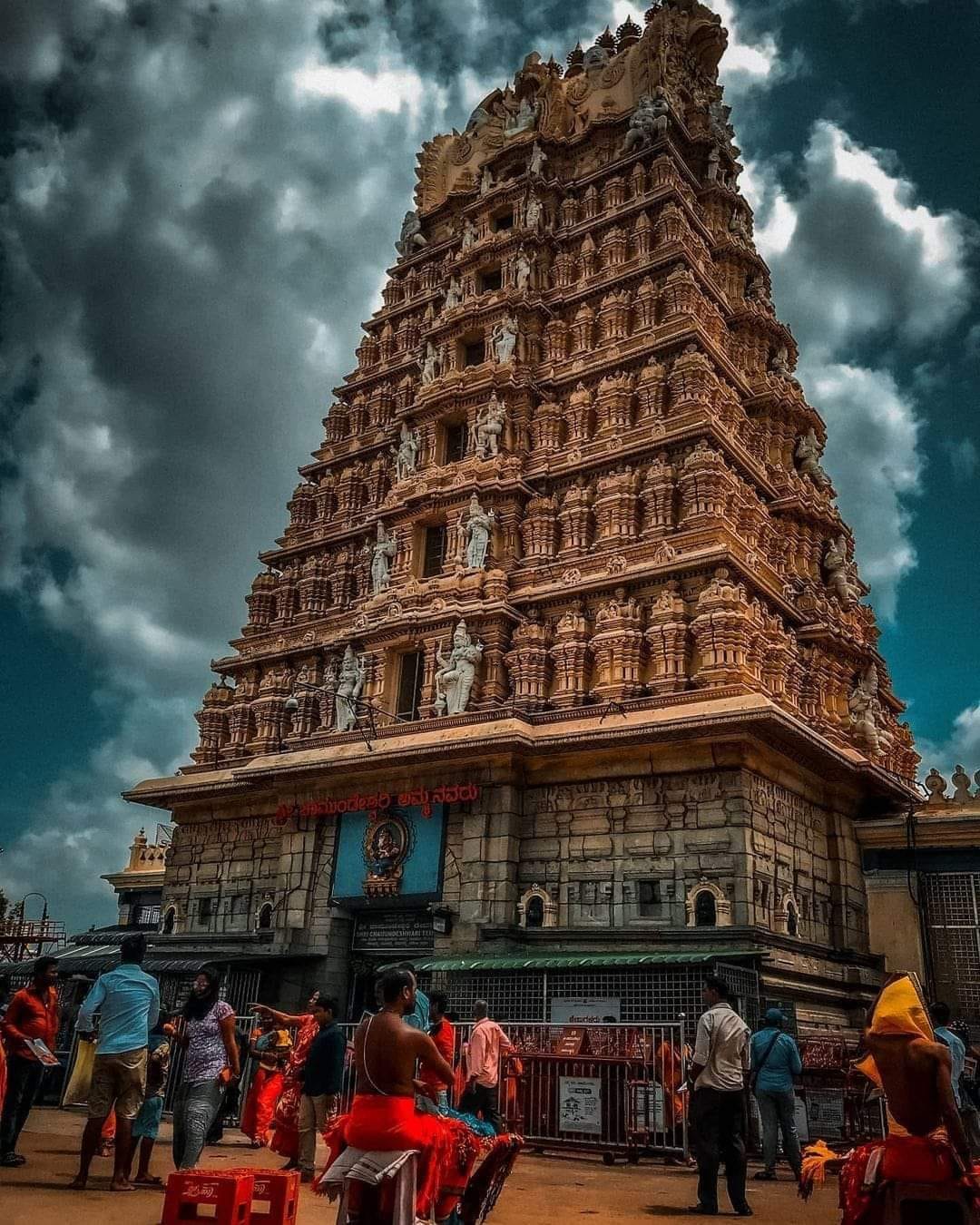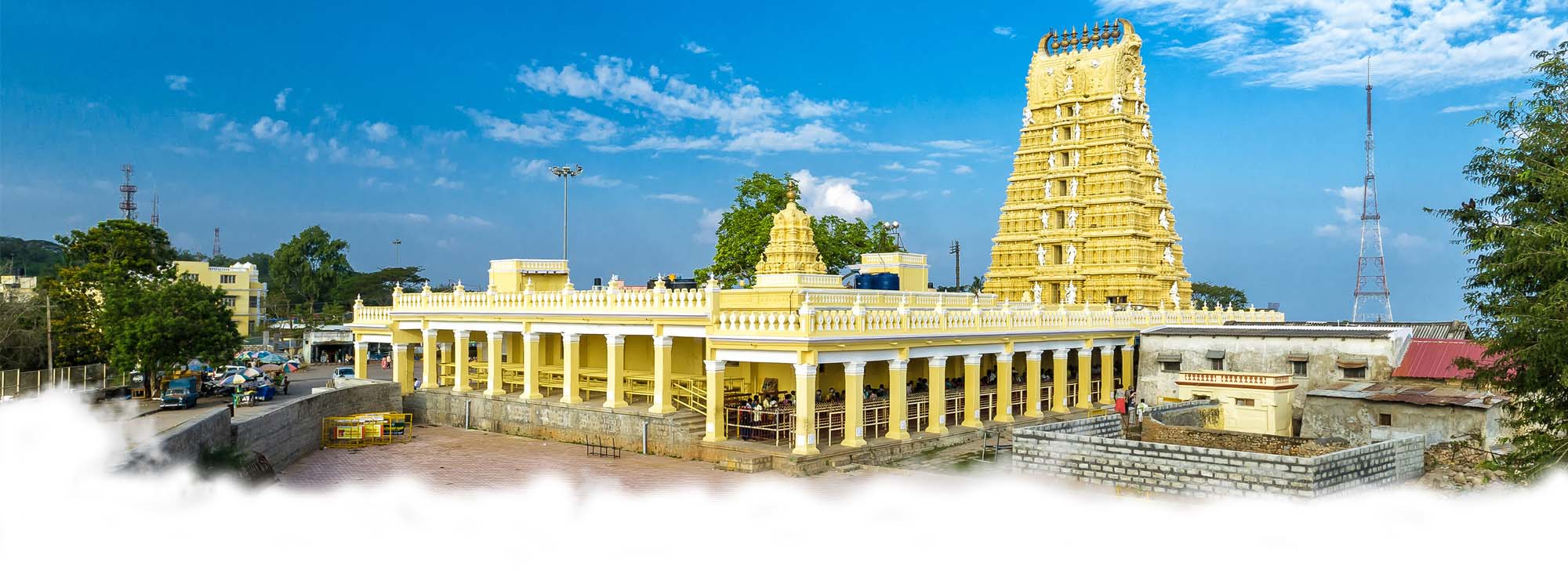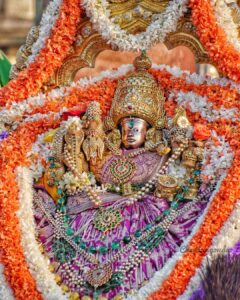
Chamundeshwari Temple in Mysuru is dedicated to Chamundeshwari Devi or Chamundi Devi, a form of Durga Devi. Located atop the Chamundi Hills in the royal city of Mysuru (Mysore) in Karnataka, it is one of the 18 Maha Shakti Peethas where Sati Devi’s hair had fallen.
It is mentioned in the Ashta-Dasha Shakti Peetha Stotram composed by Adi Shankaracharya as the Shakti Peetha located in Krouncha Puri i.e. modern day Mysuru.
lankayam shankari devi kamakshi kanchika pure
pradyumne shrinkhala devi chamunda krouncha pattane || 1 ||
There are other temples such as Mahabaleshwar on this hill too. The temple is frequented by the members of the Wodeyar royal family of Mysuru being their family’s worshipable deity. Chamundeshwari Devi comes out of the temple for a royal elephant ride (Jambu Savari) on the occasion of the world-famous Mysore Dasara every year. This festival is attended by lakhs of devotees every year from all over the world.
There are ancient Champak trees in the courtyard of the temple. These trees give at least two fragrant flowers every day. One of these flowers is offered to Chamundeshwari Devi and the other flower is sent to the Goddess residing in the Mysore Palace via a special vehicle.
History of Chamundeshwari Temple
The Devi Bhagavatam details the lila of Chamundeshwari Devi killing the demon King Mahishasura. Mahishasura was the son of the demon Rambha. Karambha and Rambha were the sons of demon Danu. They desired offspring and thus, engaged in penances. Knowing this, Indra killed Karambha who was performing penances in water by assuming the form of a crocodile.
Enraged by this, Rambha wanted to offer his head as an oblation to Agni i.e. fire. But Agni stopped him and offered him boons. Rambha desired a son who would be very powerful in all the three worlds and invincible.
Agni blessed Rambha saying that his desire would be fulfilled if he cohabits with any female living species. Rambha soon found a passionate she-buffalo in a beautiful place. Mahishasura was born as a result of the union between Rambha and the she-buffalo.
After being crowned as the king of the asuras, Mahishasura went about conquering the three worlds. He even occupied Swargaloka after fighting with Indra and the other demigods for a full 100 years. Taking shelter of Lord Brahma, the demigods headed by Indra went to Kailasa and then onto Vaikuntha to seek Lord Vishnu’s counsel.
Mahishasura is Killed
In Vaikuntha, Lord Vishnu advised the demigods to create a powerful woman using the fiery energy they possessed along with their wives. As soon as Lord Vishnu said so, a big fireball was created from the combined energies of all the demigods, Lord Vishnu, Lord Brahma and Lord Shiva.
From the fireball emerged an enchanting woman with eighteen hands. She was none other than Mahalakshmi Devi. She was awarded weapons and ornaments by all the demigods to fight and kill Mahishasura.
When Mahishasura came to know about the beauty of Mahalakshmi Devi, he sent a proposal to marry her via his prime minister. The Goddess rebuffed him and instead warned him to leave Swargaloka and go to Patalaloka or be prepared to die in a battle. Enraged by this, many asuras went to fight the Goddess on behalf of Mahishasura.
All of them including Vaaskala, Durmukha, Taamra, Chikshura, Vidhaalaksha and Asiloma were killed by Mahalakshmi Devi. Finally Mahishasura appeared in the battlefield face-to-face with Mahalakshmi Devi.
After a brief conversation between Mahishasura and Mahalakshmi Devi, the demon picked up his weapons to fight the Goddess following her second warning to go to Patalaloka or get killed. After a fierce battle between the two for 10 days, Goddess Mahalakshmi severed the head of Mahishasura with her chakra i.e. discus even though she was attacked severely.
Thus, the Goddess attained the name Mahishasuramardini for the wonderful lila of killing Mahishasura. The name Mysore or Mysuru has been derived from the name Mahishasura. Later, she slayed the demons Chanda and Munda which earned her the name Chamundeshwari.

Chamundeshwari Temple is a Maha-Shakti Peetha
The Chamundeshwari temple is a Maha Shakti Peetha as the Hair of Sati Devi had fallen here. Sati Devi had immolated herself in a yogic fire generated from her body after her father Daksha Prajapati had insulted her husband Lord Shiva. Sati Devi too was insulted for marrying Lord Shiva.
After killing Daksha and restoring his life later, Lord Shiva roamed throughout the universe holding the burnt body of Sati Devi. This caused the functioning of the universe to be disrupted. To restore the normal functioning of the universe, Lord Vishnu sent His celebrated Sudarshana Chakra to cut the body of Sati Devi.
The Sudarshana Chakra cut Sati Devi’s body into 51 pieces which fell over present-day Bharat, Srilanka, Nepal, Tibet, Pakistan and Bangladesh. Amongst them, the Hair on the head of Sati Devi fell on Chamundi hills in Mysuru, known as Krouncha Puri then. Hence, this location became a Maha Shakti Peetha.
The Chamundeshwari temple is estimated to be over 1000 years old. It was a small temple initially next to the Mahabaleshwar Temple on the hill named Mahabaladri, which is one of the eight hills that surround an area called Trimuta kshetra as per the Skanda Purana and other ancient texts. With the rise of the Wodeyars as the rulers of Mysuru in 1399 CE, the Chamundeshwari Temple acquired prominence and became a big temple as seen today.
Deities of Chamundeshwari Temple

Staying in a seated position as the Moolavar Deity, Chamundeshwari Devi with eight arms (Ashta-Bhuja) resides inside the Garbagriha i.e. sanctum sanctorum. The Utsavar i.e. festival deity which resides in the Mysuru palace is made of Panchaloha i.e. five metals. It is brought and worshipped first before the announcement of the Mysuru Dasara.
The Srichakra is also worshipped in the sanctum. At the entrance are the two doorkeepers i.e. Nandini and Kamalini.
On the right side, after entering the Chamundeshwari temple is a deity of Lord Ganesha. And on the right side before the Dwaja-Stambha is the deity of Bhakta Hanuman embedded in the wall. Before the Garbagriha is the deity of Bhairava, a form of Lord Shiva.
Architecture of Chamundeshwari Temple
The temple structure was originally built by the Hoysala dynasty kings in the 12th century. Later, one of the Vijayanagar kings built the Gopuram in the 17th century. In 1659 CE, King Dodda Devaraja Wodeyar built 1000 steps to reach the temple easily.
Later, King Krishnaraja Wodeyar III renovated the temple in 1827 CE with the addition of a beautiful Gopuram. The Gopuram is seven tiered with seven golden Kalashas atop them.
The temple has a quadrangular structure built in the Dravidian way. It comprises of the main doorway entrance, Navaranga hall, Antarala Mantapa, Garbhagriha with Vimana and Prakara.
Festivals of Chamundeshwari Temple
Navaratri, Ashada Shukravara, Ammanavara Vardhanthi and Chamundi Jayanthi are the important festivals celebrated in the temple. The Mysore Dasara is very famous globally. It is celebrated as the Nadu Habba i.e. state festival of Karnataka.
Chamundeshwari Devi is adorned in the Navadurga Rupa over nine days. On the seventh day of Navaratri dedicated to Kalaratri Devi, the deity is adorned with jewels donated by the Mysuru Maharajas.
AshadaShukravara refers to the Fridays of the Ashada month which is very important here. The Chamundi Jayanthi is also celebrated in this month to commemorate the installation of the Utsavar Murti by the Maharaja of Mysuru.
Temple Timings of Chamundeshwari Temple
From the opening time to closing time, the Chamundeshwari temple closes only for a short period. You can have darshan and offer poojas at the following times –
Morning: 7.30 AM to 2 PM
Evening: 3.30 PM to 6 PM
Abhisheka Timings –
Morning: 6 AM to 7.30 AM
Evening: 6 PM to 7.30 PM
On Fridays, the timings are from 5 AM to 6.30 AM
How to Reach Chamundeshwari Templea
The best way to visit the Chamundeshwari Temple is to choose your tour with Tirtha Yatra. You have to reach Mysuru city to have darshan at the Chamundeshwari Temple. There are frequent buses to the Chamundeshwari temple from the city bus stand. It takes just 20 minutes to reach the Chamundi foothill.
You can use the following means to reach Mysuru city –
By Road: Mysuru is well-connected by state and national highways to Bengaluru and other cities in Karnataka and beyond. Bengaluru/Bangalore is 155 kms away. Both state and private bus services connect the city to other cities in Karnataka and other states.
Taxis are available from nearby cities. The upcoming Bengaluru-Mysuru Expressway will be a game-changer.
By Rail: Mysore Junction (MYS) serves the city of Mysuru. This railway station connects the city to all the major cities of India. You can board a train from your city to Mysuru and catch a bus/taxi to the temple.
By Air: The Mysore Airport 10 kms south of the city serves Mysuru. You can fly in here via domestic flights and take a bus/taxi to the temple. The nearest International airport is at Bengaluru 185 kms away.
0










Leave a Reply